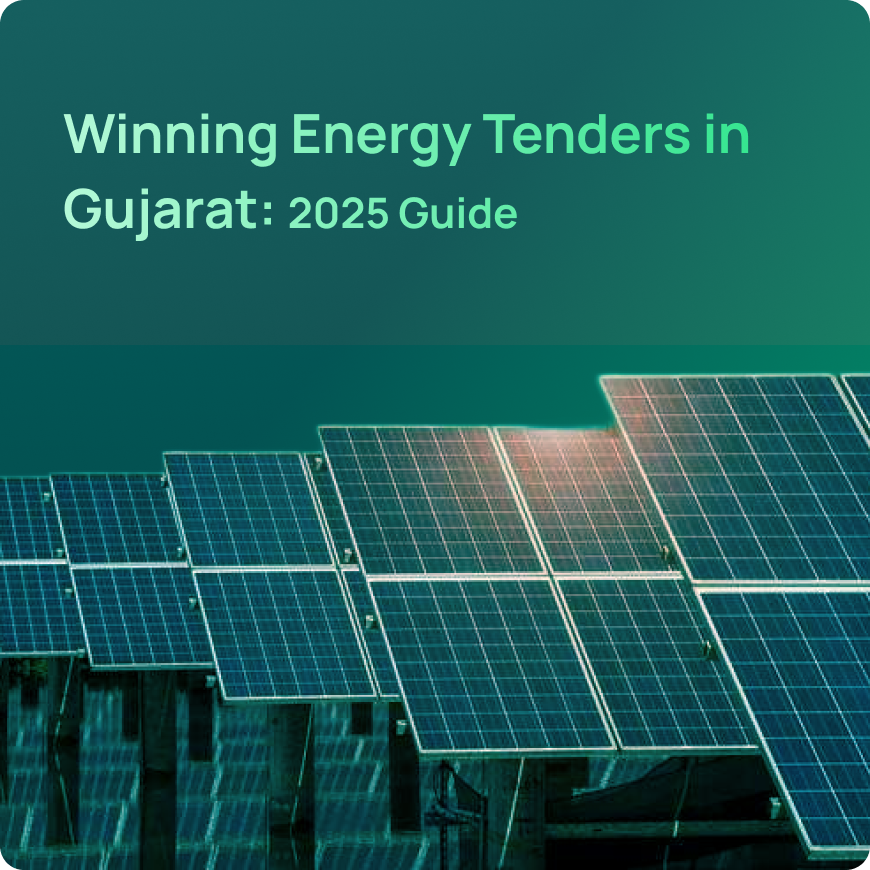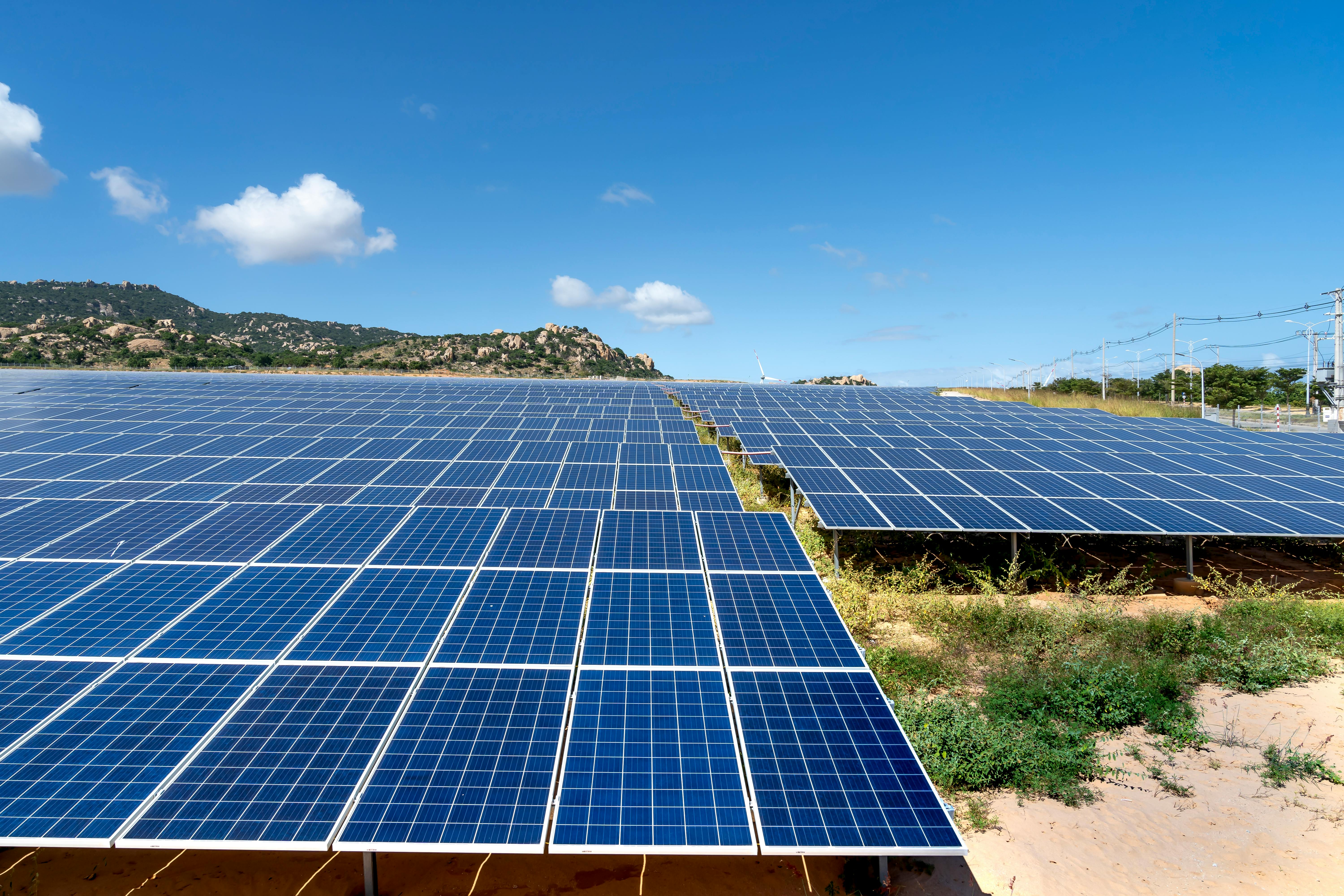How to Win More Energy Tenders in Gujarat: A Smart Guide for 2025
Gujarat's rapidly expanding renewable energy sector, particularly solar, presents a lucrative landscape for businesses.

Gujarat is rapidly expanding its renewable sector – in 2024 it added a record 7,449 MW of green energy (6,179 MW solar), bringing its total renewables to ~31.5 GW by year-end. This growth feeds a steady pipeline of Gujarat tenders – especially solar energy tenders from state agencies. India’s total installed solar capacity tops 110 GW. (Gujarat ~14.2 GW). Our guide explains how to prepare bids, leverage data, and use AI tools to win more government solar and energy tenders in Gujarat.

Gujarat’s Energy Tender Landscape
Gujarat leads India in solar deployment. The Khavda (Gujarat Hybrid) park alone plans 30 GW of solar+wind capacity – a scale that translates into giant tender opportunities. State utilities like GUVNL regularly float large RfS: for example, in May 2025 GUVNL issued a request for 500 MW of solar power (with an optional “greenshoe” 500 MW). Bids are fiercely competitive – recently GUVNL awarded 250 MW at only ₹2.60/kWh. Meanwhile, national agencies are slowing down (only ~14.4 GW of solar tenders floated in Q1 2025, down 53% YoY, so targeting Gujarat-specific tenders (and GeM solar tenders) is smart. Note also that MNRE has a 50 GW annual renewables auction target, and Gujarat’s policies (e.g. 2023 solar policy) are aggressively pushing new capacity.
Key Insight: Gujarat’s renewables push (31.5 GW RE by 2024) means frequent tender releases. Major bidders analyze past awards (like ₹2.60/kWh wins) and position accordingly.
Pre-Bid Preparation
Read and Summarize the RfP: Examine every clause of the RfS/RFP. AI tools can help – for example, ContraVault AI swiftly analyzes your tender documents and provides a comprehensive summary so you never miss a crucial point. Use such summaries to note requirements (project scope, timelines, compliance checks) early.
Ensure Financial Compliance: Arrange your Earnest Money Deposit (EMD), document fees, and eventual bank guarantees ahead of time. For instance, recent GUVNL solar tenders required an EMD of ₹0.928 M/MW and a net worth of ₹9.28 M/MW. Have financial statements and BGs ready to avoid disqualification.
Technical and Regulatory Checks: Verify technical specs (e.g. approved module types, tracker requirements) and legal conditions. Ensure your bid meets Domestic Content Requirements or other local content rules if any. Gather certifications (IEC/BIS approvals) and past performance proof to include in the bid.
Translation and Clarity: If any tender documents use Gujarati or complex technical language, use AI or human translators to clarify them. Tools like ContraVault also claim to auto-translate tender docs, ensuring you catch clauses otherwise lost to language barriers.
Alerts and Tracking: Subscribe to tender alerts on official portals (CPPP, GUVNL/GETCO sites) or AI platforms. Platforms like TenderPost promise “instant notifications for relevant government tenders” and even let you filter specifically for GeM or state tenders. Never rely on memory – missing a deadline is fatal.
Quick Checklist: Ensure EMD/BG availability, all RFP clauses are understood (and summarized), and any language issues are resolved. Pre-assemble standard documents (company profile, financials, technical specs) so you can compile the bid quickly once the RfS is out

Smart Bidding Strategies
Market-Driven Pricing: Base your tariff quotes on recent benchmarks. For example, winning bids in Gujarat have been near ₹2.60/kWh. Bid aggressively but sustainably; an underbid might win the job but hurt margins, while an overbid likely loses. Use past award data and tender analytics to calibrate pricing.
Scale and Flexibility: Decide on the bid capacity wisely. If the tender allows an optional “greenshoe” expansion (as GUVNL does), plan whether to bid the full capacity outright or secure the initial lot. Sometimes bidding a little lower capacity with firm commitment is safer. Consider joint ventures if your firm alone can’t meet size or experience criteria.
Value Proposition: Highlight your strengths in the bid. For instance, stress a faster project timeline, better technology (e.g. bifacial panels, advanced trackers), or a strong O&M plan. Show alignment with govt. goals (like rural electrification or rural employment via training local labor). Demonstrating such value can tip a tight decision.
Clean Submission: Ensure the bid submission is flawless. Any missing form or compliance gap can disqualify you even if your price is low. You can use AI checklists: ContraVault offers libraries of “pre-built compliance checks” to verify everything. Double-check forms, attach all certificates, and write a clear cover letter.
Risk Management: Account for penalties and delays. For example, GUVNL’s tender stipulated ₹2.32 M/MW liquidated damages for 6-month delay. Incorporate such risks into your project plan and price (or explain mitigation plans) to avoid surprise costs.
Pro Tip: Treat every RfS like an exam. Score as high as possible in eligibility, technical strength, and financial health – leaving “just bid price” as the remaining variable. In practice, many bids are won on very small price differences, so eliminate other weaknesses first.
How AI Can Help You Win More Energy Tenders in Gujarat
In Gujarat’s fast-evolving energy sector, spanning renewable power, transmission infrastructure, and utility-scale projects, timely and accurate tender responses are crucial to winning bids. ContraVault AI offers a suite of powerful tools tailored to help energy companies compete more effectively and efficiently.
Energy tenders often include stringent technical, financial, and regulatory preconditions. AI-powered Go/No-Go Analyzer instantly evaluates each tender against your company’s internal benchmarks, such as project size, location, financial thresholds, and compliance needs. It provides a confidence score and clear recommendations, ensuring you pursue only the most viable opportunities, saving time and resources.
Risk Finder – Energy-Specific Risk Detection
Energy tenders in Gujarat may carry hidden risks related to land acquisition, regulatory clearances, environmental obligations, or tariff mechanisms. Risk Finder automatically flags such risks, both from within the tender document and from external sources like regulatory updates and vendor history. It assigns risk scores based on likelihood and cost impact, providing mitigation strategies upfront so you can make informed, proactive decisions.
Voluminous tenders can bury crucial details. AI Synopsis generation engine distills entire tender documents into concise, structured summaries customized to your team’s preferred format. Whether it’s commercial, legal, or technical requirements, the tool captures and highlights key components, enabling faster internal alignment and quicker decision-making.

Leveraging Government Portals and Networks
Don’t overlook official channels: tender notices often appear on government platforms. The Government e-Marketplace (GeM) lists procurement opportunities for solar panels and equipment – regularly check GeM solar tenders for bids on modules, inverters, etc. State portals (GUVNL, GETCO, etc.) and the CPPP (Central Public Procurement Portal) are the primary sources for power project RFPs.
Networking also helps. Join industry associations or attend energy conferences in Ahmedabad/Gandhinagar to hear about upcoming tenders. Make sure your company is registered on relevant portals and that key staff have digital signatures (DSC) for e-tendering. When submitting, reference past projects (for example, “Company X successfully completed a 50 MW solar park under MP Urja Vikas Nigam” – see Mercom for similar context). Citing established players and contracts can reassure evaluators of your credibility.
Government Tender Tip: Many state tenders now have online pre-bid conferences. Participate in these to get clarifications (and maybe subtle hints on evaluation). Build relationships with tendering officials by asking pointed questions – just make sure all questions are allowed under the inquiry rules.
Conclusion: Winning more energy tenders in Gujarat means combining diligent preparation with smart, data-backed strategies. Start by preparing thoroughly (leveraging AI translation and tender analysis), then bid competitively (referencing recent Gujarat award prices), and continuously analyze tender data (using industry reports and dashboards). By doing so, you’ll be best positioned to capture Gujarat’s booming government solar and energy procurement opportunities.